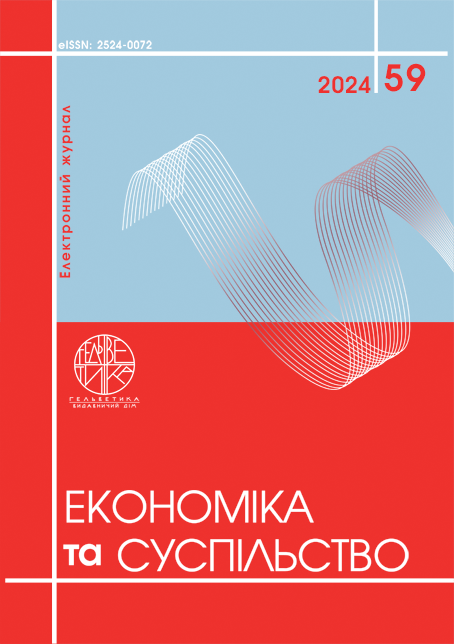DEVELOPMENT OF CREATIVITY AS A COMPETITIVE ADVANTAGE OF ENTERPRICE
Abstract
Global economic turmoil caused by two waves of the COVID-19 pandemic and its consequences today are aggravated by the acute challenges of wartime in Ukraine, and despite the undoubted difficulties of the global economy today, there is a trend towards an increase in the profitability of enterprises due to increased attention to the development of creativity, the creative class and creative industries, because the creative economy leads to comprehensive economic development and creates an investment climate, attracting and even forcing to look for new opportunities and partnerships both at the global and local levels. The creative economy existed to some extent before: talented "creators" who bring their ideas (inventions or just current events) to life can sometimes earn money by times their activities. However, the creative economy was able to create its own market, carrying out planned development only in the last ten to fifteen years. All this happens thanks to the Creatively Thinking Enterprise. Therefore, creativity, as a competitive advantage in the development of the company's profitability, makes it possible to respond to the challenges of the times, and to make a profit that is not obvious at first glance. The creative economy is considered in various areas of socio-economic development. The creative process aimed at gaining a competitive advantage for an enterprise can usually be divided into four main stages: clarify problems and set goals; generate new ideas; choose the best method from the proposed ideas; review proposals and prepare a plan for their implementation. If you try to skip one of them, you may forget the best solution and ignore all the risks. Ignoring the first step can result in focusing on the ideas that don't help solve the problem, and skipping the fourth step means the team will not be able to move forward with the selected ideas. The creative economy can be considered as a source of inspiration for this in many ways. It provides an attractive climate for investment, modernization of education and science; development of certain areas of the social sphere, etc. - the work of the creative economy, and the economy as a whole. New, higher formation of a system of related socio-economic relations. They decide to find more complex strategies to satisfy their needs. Needs may vary, they may be traditional or popular, or mainly new, non-standard innovative methods and technologies, creative technologies.
References
Center for Market Economy Development. Креативна економіка: нова економічна епоха ХХІ ст. 2021. URL:https://creativeeconomy.center/wpcontent/uploads/2021/12/2_5332503104040474153.pdf (дата звернення: 08.02.2024).
Лошковська Х.С. Тенденції розвитку креативності в контексті міжнародного бізнесу. Ефективна економіка № 3, 2014. URL: http://www.economy.nayka.com.ua/?op=1&z=2860 /(дата звернення: 7.02.2024).
Литвиненко С. Креативність як загальна здібність до творчості: сучасні підходи // Збірник наукових праць полтавського державного педагогічного університету імені В.Г. Короленка. – Серія «Педагогічні науки». – випуск 3 (50). – Полтава, 2006. – С.215¬219.
Поснова Т. В. Передумови та фактори формування креативного людського капіталу в умовах постіндустріального суспільства. Ефективна економіка, №3,2019. URL:http://www.economy.nayka.com.ua/pdf/3_2019/51.pdf/ (дата звернення: 7.02.2024).
Флорида Р. Креативний клас: люди, які змінюють майбутнє / Пер. с англ. — М.: Издательский дом «Классика ХХI», 2007.— 42 с. URL:https://soulbooks.com.ua/ua/p1605596372-kreativnyj-klass-lyudi.html /(дата звернення: 7.02.2024).
Гулик Т.В., Найдовська А.О., Забігай В.В. Складові системи адаптації маркетингової стратегії. Економіка та суспільство. 2021. No 33. Хмельницький:ХНУ,2021.С.178¬181. URL:https://economyandsociety.in.ua/index.php/journal/article/view/864 / (Дата звернення: 9.01.2024)
Center for Market Economy Development. Kreatyvna ekonomika: nova ekonomichna epokha ХХI st. (2021) [Creative economy: a new economic era of the 21st century] Golocal, Tsentr rozvytku kreatyvnoyi ekonomiky, CMT. URL:https://creativeeconomy.center/wpcontent/uploads/2021/12/2_5332503104040474153.pdf
Loshkovsʹka KH.S. (2014) Tendentsiyi rozvytku kreatyvnosti v konteksti mizhnarodnoho biznesu [Trends in the development of creativity in the context of international business]. Efektyvna ekonomika, no. 3. URL: http://www.economy.nayka.com.ua/?op=1&z=2860
Lytvynenko S. (2006) Kreatyvnistʹ yak zahalʹna zdibnistʹ do tvorchosti: suchasni pidkhody [. Creativity as a general ability to creativity: modern approaches]. // Zbirnyk naukovykh pratsʹ poltavsʹkoho derzhavnoho pedahohichnoho universytetu imeni V.H. Korolenka. – Seriya «Pedahohichni nauky». – vypusk 3 (50). – Poltava, P.215¬219. (in Ukrainian)
Posnova T. V. (2019) Peredumovy ta faktory formuvannya kreatyvnoho lyudsʹkoho kapitalu v umovakh postindustrialʹnoho suspilʹstva. [Prerequisites and factors of formation of creative human capital in the conditions of post-industrial society]Efektyvna ekonomika, no. 3. URL:http://www.economy.nayka.com.ua/ pdf/3_2019/51.pdf
Floryda R. (2007) Kreatyvnyy klas: lyudy, yaki zminyuyutʹ maybutnye [Creative class: people who change the future] / Per. s anhl. — M.: Yzdatelʹskyy dom «Klassyka XXI», 42. URL:https://soulbooks.com.ua/ua/p1605596372-kreativnyj-klass-lyudi.html
Hulyk T.V., Naydovsʹka A.O., Zabihay V.V. (2021) Skladovi systemy adaptatsiyi marketynhovoyi stratehiyi. [Components of marketing strategy adaptation systems] Ekonomika ta suspilʹstvo. 2021. No 33. Khmelʹnytsʹkyy: KHNU, S.178¬181. URL:https://economyandsociety.in.ua/index.php/journal/ article/view/864

This work is licensed under a Creative Commons Attribution 4.0 International License.


